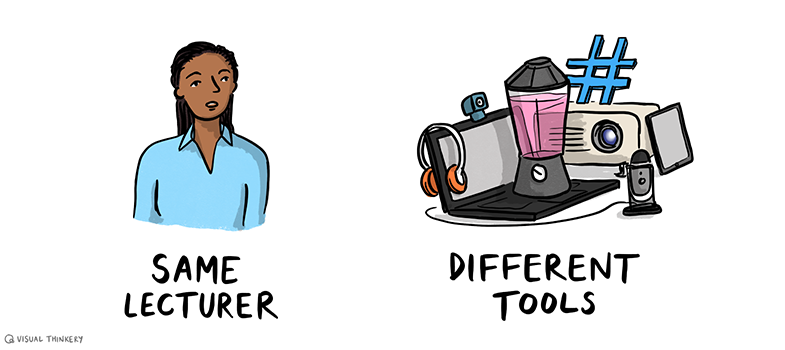2.1 Flipped classrooms
‘Flipped learning’ reverses the traditional classroom approach to teaching and learning. At home, learners watch videos, listen to audio recordings, read books or worksheets. These resources allow learners to work at their own pace, pausing to make notes where necessary. Some learners – though not all – will be able to access help and support from their peers or family members. This independent study means there is time in live sessions with the educator for activities that encourage learners to think critically about the information they have studied. Live sessions become a time to explore subjects with the support of the educator and fellow learners.
The flipped learning approach has two parts: direct instruction at home and an interactive element in the seminar room or lecture theatre. The direct instruction can focus on readings or audio recordings, but often consists of videos. These may be ones made by the educator, or they could be ones that have been shared online.
Activity 2.4 The flipped classroom
This video synthesises the benefit of a flipped classroom approach.
Watch the video, or read the transcript, and make a note of three benefits of the flipped classroom.
Transcript
Comment
This activity is intended to introduce you to the concept of the flipped classroom approach, and to help you to identify the benefits it may have for you in your own context.
The benefits suggested for the flipped classroom approach include the ability for students to work through materials at a pace that suits them, and a reduction in boredom for students who are finding the material easier. The educator can spend class time addressing individual needs.
There is a wider theme that can be found in this video and elsewhere in this course. This is the way that the role of an educator can change in response to a change in approach using technology. In the case of the flipped classroom, the educator is seen to become more of a ‘coach, mentor, and guide’, rather than acting primarily to deliver knowledge. You might see this as a benefit, depending on your point of view on what the role of an educator should be.
Now that you have been introduced to some of the unique aspects of online education, the differences between synchronous and asynchronous elements, the possibilities of blended learning and the notion of the flipped classroom, the next activity prompts you to reflect on your own practice and how it might fit with what you have learned so far.
Activity 2.5 Making plans
Now that you have read a little about the basics of online education, think about your goals in this area. These may be wide-ranging or they may focus on one task that you do regularly. Note answers to the following questions if you can:
- What do you want to achieve online? Do you aim to transfer online a small or substantial element of face-to-face teaching? Do you want to improve the online teaching that was developed quickly during the pandemic? Do you want classes to take place entirely online or would a blended approach be better? What is the best balance of synchronous or asynchronous activities likely to be? Is a flipped classroom approach appropriate?
- Who are your students? What are their online skills? What support might they need to study successfully online?
- What resources do you have that you might be able to repurpose to support online learning?
Record your responses below and, if you wish, share some ideas in the course community of practice Facebook group.
Comment
This is one of a series of activities that appear throughout this course, helping you to develop a plan for taking education online or for developing your current practices. You may find it helpful at this stage to keep a range of options available, perhaps listing several ideas for each point.
2 Blended learning






